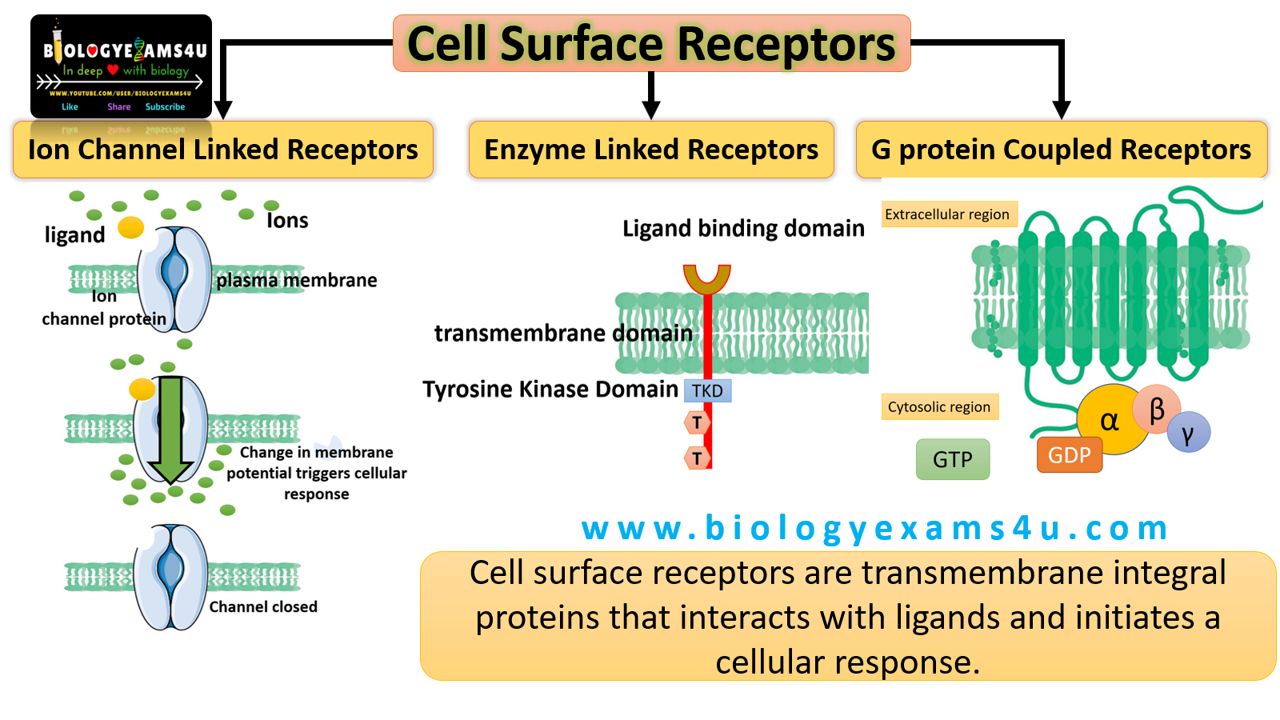Receptors
in Cell Signaling
Cell surface receptors are transmembrane integral proteins that interact with ligands and initiates a cellular response.
The receptors may be present either on the cell surface or inside the cell depending on the chemical nature of ligand or signaling molecule.
1. Cell surface
receptors: Hydrophilic (water soluble) molecules
cannot pass through lipid membrane as lipid membrane is hydrophobic.
Hydrophilic molecules include peptide hormones like insulin and glucagon binds
to receptors in the plasma membrane.
2. Intracellular receptors: lipophilic hormones like estrogen have intracellular receptors either on cytoplasm or nucleus. This hormone receptor complex directly binds to regions of DNA activating transcription of certain genes.
3 types of cell surface receptors:
1. Ion Channel Linked Receptors
2. Enzyme Linked Receptors
3. G protein Coupled Receptors
a) Extracellular domain: also called as recognition domain; that binds to the ligand
b) Membrane spanning region: hydrophobic region
c) Intracellular domain: contact with cytoplasm also known as coupling domain transmits signals to the interior of the cell.
1. Ion Channel Linked Receptors
· Ionotropic receptors
· Ion channel gated receptor
· pore-forming membrane proteins that allow ions
to pass through a channel pore
Ligand gated ion channels
Allow ions to flow into or out of the cell in
response to the binding of a ligand to their respective receptors. Eg:
Acetylcholine Receptors.
At the nerve muscle junction, the
neurotransmitter acetylcholine binds to specific receptors that allows Na+
ions to flow into and K+ ions out of the target cell.
GABA receptors: that allow chloride ions to
flow into a cell upon agonist (GABA) binding.
Voltage-Gated Ion Channels
Ion channels that open and close in response to changes in membrane potential
2. Enzyme Linked Receptors:
- These receptors have a catalytic activity that is activated by binding of the ligand.
- This receptor has intrinsic enzymatic activity or are associated with an enzyme (usually a kinase)
Kinases (Protein Kinases [PKs])
• enzymes that
catalyze the phosphorylation of target molecules to cause their
activation. In other words, they add a
phosphate group to a molecule/protein/another kinase.
Phosphatases • enzymes that catalyze the
dephosphorylation of target molecules. This dephosphorylation usually
inactivates the target molecule (effector). Phosphatases act in opposition to
kinases.
It is the balanced activity of kinases and phosphatases that results in effective, signal transduction.
An example is tyrosine-kinase receptors
(RTK).
Binding of an often-dimeric ligand induces
dimerization of the receptors that leads to cross phosphorylation of the
cytosolic domains and phosphorylation of other proteins.
RTKs bind growth factors like EGFR, NGF to
signal processes that result in the regulation of cell growth, differentiation
and survival through transcription of associated genes.
This video summarizes 3 types of receptors.
3. G protein Coupled Receptors (GPCR) or 7 transmembrane receptors
- largest family of transmembrane signaling proteins
- known as seven-(pass)-transmembrane domain receptors (7TM receptor), due to the seven alpha helices that transverse the cellular membrane.
- The receptor recognizes the appropriate ligand to activate the G proteins.
- There are approximately 950 different human genes encoding GPCRs
These receptors are coupled to intracellular GTP-binding proteins (G-proteins). Once activated, G-proteins trigger the production of a variety of second messengers (e.g. cyclic AMP [cAMP], inositol triphosphate [IP3], diacylglycerol [DAG], etc.) helping to regulate a number of body functions ranging from sensation to growth to hormone release.
Understand more: Diagram Quiz on Cell Signaling
*A second messenger is a substance that is released in the cytoplasm following activation of a receptor. It is non-specific, short lived and can generate a variety of responses in the cell. Eg: cAMP, DAG (di acyl glycerol), Ca2+, IP3.

